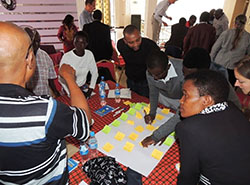Six months after his MSc Animal Sciences, Wilson Charles returned to Wageningen University in April 2018 for a PhD program while registered at Plant Production Systems group. Primarily, he joined N2Africa and The Missing Middle project where his research focuses on exploring the role of the current soyabean-chicken-maize value chains in sustaining diverse diets in the Southern Highlands of Tanzania. The focus was on these value chain(s) since integrating soyabeans in the integrated maize-chicken value chains might improve soil fertility and subsequent maize yield through Nitrogen fixation and increase the productivity of chickens by providing nutrient-dense feed. These chickens are needed to meet the growing demand for eggs and meat in the country.
| The current research involved a scoping study followed by an in-depth literature review and interviews using semi-structured questionnaires to understand chicken farming typology whereby 121 poultry keepers were interviewed in three districts of Iringa region. Furthermore, we carried out a multi-stakeholder workshop with 54 stakeholders and experts involved in the development of the maize, soyabean and chicken value chain(s) to identify important points for value chain integration, to support nutritious diets in the region. |
Figure 1. A participatory workshop on value chain mapping and stakeholders analysis in Iringa region. |
Three systems of poultry keeping were identified in the study area i.e. extensive, semi-intensive and intensive systems, with diverse feeding strategies ranging from scavenging, home-made ration, industrial feed and combination of home-made and industrial rations. Poultry feeds processed by local industry is either supplied to large scale chicken farmers or to the agents who supply to the smallholders, mid-scale farmers and brooders. The informal chicken market (for eggs, live/slaughtered chickens) dominates both urban and rural location.
The current maize, soyabean and chicken value chains inter-connected particularly at the levels of the smallholder farming system and at processing facilities. The production of one or more of these products contribute to farmers’ food security and income. Poultry feed is an important entry point for integrating the three value chains, whereby maize (grain/bran) and soyabean meal could serve as the main sources of energy and protein for chicken, respectively. Currently, crop farmers play important roles in supplying feed ingredients to the grain market, feed-ingredient suppliers, feed processors, hatcheries and chicken farmers, mainly through middlemen. A small proportion of maize produced is exported to neighbouring countries, while the current amount of soyabean produced is mainly marketed in the domestic market.
Although the introduction of soyabeans is promising, the locally produced grains are underutilized due to inefficient marketing and processing in the country, mainly due to disorganised producer groups and lack of adequate processing plants. As a result, soyabean meal is mainly imported and sold at almost three times higher prices than the whole soyabean grain produced in the country. Improving soyabean marketing and investment in processing infrastructures has a great potential in promoting soyabean production and ultimately contribute to increasing local availability of soyabean meal (as well as oil and flour). Improving availability of locally produced soyabean meal might reduce the cost of feed-in chicken farming and consequently promoting the production of chicken eggs and meat to meet the increasing demand of chicken meat and eggs for urban and rural consumers.
In the next step, we will further assess the quality of chicken feed and feed ingredients and exploring different feeding strategies in Tanzania. More specific, we will explore the alternative protein sources that would supplement fish meal in poultry feed formulation which is currently scarce. A better understanding of feed quality and feeding strategies is expected to reveal the gaps hindering chicken productivity and exploring the opportunities for the utilization of soyabean as a supplement of fish meal in a view of food-feed competition.
Wilson Charles Wilson, Wageningen University & Research, The Netherlands (No previous updates)

